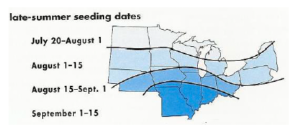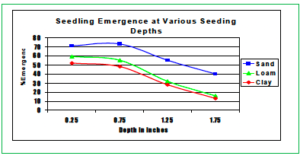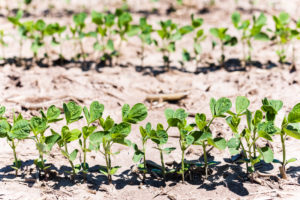Late-Summer Seeding Alfalfa
By Dave Robison | July 27, 2022
Late-Summer Seeding Alfalfa: A Viable Practice
While many producers prefer spring seeded alfalfa, certain soil types or excessive spring rainfall may cause Midwestern producers to postpone spring planting alfalfa. Instead of waiting until the next spring to plant, many farmers in these areas have success by sowing their alfalfa in the late summer. There are many benefits that late-summer seeding alfalfa brings to the producer. Along with these benefits, there are also risks to manage to ensure successful planting. Both the benefits and risks are listed below.
Benefits of Late-Summer Seeding
One of the benefits of late-summer seeding alfalfa is that across much of the region fall rains and cool temperatures provide an ideal environment for seedling growth and establishment of alfalfa. This is also a very good time to establish cool-season grasses with the alfalfa. There is also less risk of fungal diseases usually associated with the cool damp conditions in the early spring.
Another benefit of late-summer seeding alfalfa is that the field work can be accomplished while there are fewer time constraints. An excellent practice is to prepare the seedbed mid-summer and plant the alfalfa when there is adequate moisture. During this time, there is less pressure to plant other crops. This also allows the farmer to control weeds with tillage before planting his alfalfa in the late-summer.
Late-summer seeding also enhances yield potential during the first year. By planting at this time the producer has an excellent opportunity to harvest a full crop of alfalfa in the year following establishment. This additional yield in the first harvest year can be quite profitable. Forage yield the year following late-summer establishment is generally equal to “harvest year one” a year after a spring-seeded crop.
Special note: While it may be tempting to harvest a new seeding in the fall after a killing frost, it is important to leave the growth un-harvested to ensure having adequate carbohydrate reserves in the roots.
Risks of late-Summer Seeding
While spring seeded alfalfa is often planted with oats or triticale as a companion crop to help control weeds, it is important NOT to use a companion crop with late-summer sown alfalfa. Companion crops can take vital moisture away from late-summer seeded alfalfa seedlings. There will also be less need for a companion crop because there will be less weed pressure in the late summer. If weeds are a problem consider using chemical weed control.
A major risk to be concerned about is the amount of moisture available to establish a good stand of alfalfa. Successful late-summer seeding depends on soil moisture during the establishment period. Do not sow alfalfa unless good soil moisture is present. Irrigation allows late summer seeding in all areas. Again, use of a companion crop is not recommended because it competes with alfalfa for moisture.

Alfalfa needs at least 6-8 weeks growth after germination to survive the winter. The plant will generally survive the winter if it develops a crown before a killing frost. Fields with less seedling development before a killing frost may have a greater problem with winter annual weeds. The objective is to have 6-8” of growth before a killing frost. The chart above shows target dates to have your alfalfa seeded. The later a producer seeds, the greater risk of stand failure.
Properly Prepare the Seedbed

A properly prepared seedbed is vital for establishing alfalfa. A well worked, firm seedbed with seed placed at ¼ -½” deep provides an excellent opportunity for starting a high yielding alfalfa field. It is also important to have proper pH (6.7-7.0) and P and K fertility levels should be in the high range before seeding.

Warning: Do not seed alfalfa in the fall after alfalfa was harvested and killed at first cutting. Alfalfa has autotoxic plant compounds that inhibit new seedlings from establishing. Wait approximately one year after killing an alfalfa stand before reseeding the field back to alfalfa.
Choose the Right Seed
The choice of variety is also a major factor in having success in the late-summer seeding. Producers should sow varieties that have a record of excellent seedling vigor, winterhardiness, and high multiple pest and disease resistance. It is important to choose varieties that have high profit potential.
Producers should not plant “cheap” alfalfa as it often results in lower yields, lower forage quality, and shorter stand life. Varieties included in the Legacy Seeds alfalfa line-up often out-yield “cheap” varieties by 25-30%.
Legacy Brand Alfalfa is coated, pre-inoculated, and treated with a fungicide. Fungicides provide good insurance against stressful weather conditions. Sowing seed that is coated, pre-inoculated, and treated with fungicide has proven beneficial in establishing stands of alfalfa in the late-summer.
Conclusion
If there is adequate moisture in the late-summer, producers can enjoy the benefits of late-summer seeding. By planting at the proper time, using high quality pre-inoculated and treated seed of an improved variety, and exercising good management skills, most producers should have excellent success with late-summer seeding of alfalfa.


